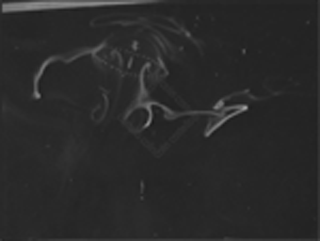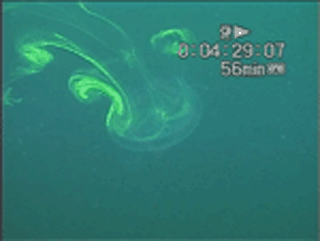Flow patterns generated by medusan swimmers such as jellyfish are known to differ according the morphology of the various animal species. Oblate medusae have been previously observed to generate vortex ring structures during the propulsive cycle. Owing to the inherent physical coupling between locomotor and feeding structures in these animals, the dynamics of vortex ring formation must be robustly tuned to facilitate effective functioning of both systems. To understand how this is achieved, we employed dye visualization techniques on scyphomedusae (Aurelia aurita) observed swimming in their natural marine habitat. The flow created during each propulsive cycle consists of a toroidal starting vortex formed during the power swimming stroke, followed by a stopping vortex of opposite rotational sense generated during the recovery stroke. These two vortices merge in a laterally oriented vortex superstructure that induces flow both toward the subumbrellar feeding surfaces and downstream. The lateral vortex motif discovered here appears to be critical to the dual function of the medusa bell as a flow source for feeding and propulsion. Furthermore, vortices in the animal wake have a greater volume and closer spacing than predicted by prevailing models of medusan swimming. These effects are shown to be advantageous for feeding and swimming performance, and are an important consequence of vortex interactions that have been previously neglected.
John O. Dabiri, Sean P. Colin, John H. Costello and Morteza Gharib Journal of Experimental Biology 208, 1257-1265 (2005)

Download the Paper (PDF File, 507KB)
Videos (click thumbnails):

Dye around several rowing medusae. In order of appearance species include: Phialidium sp., Solmissus sp. and Aurelia aurita. Ending diagram show how the medusae can use the flow for propulsion and feeding. (Quicktime File 16,317 KB)
Flow generated by swimming Aurelia aurita visualized using flourescene dye. Notice that stopping vortex that forms inside the bell during bell relaxation and the starting vortex in the wake that forms during bell contraction. Presence of these two vortices is characteristic of rowing propulsion. The clip also shows prey (brine shrimp) being entrained in the flow and captured by the tentacle. Rowing medusae are generally cruising predators and generate flow as a feeding current. (Quicktime File 3,553 KB)
Other Related Studies:
Colin, S. P. and Costello, J. H. 2002. Morphology, swimming performance and propulsive mode of six co-occurring hydromedusae.J. Exp. Biol. 203: 427-437.
(PDF File, 462KB)
Colin, S. P. and Costello, J. H. 1996. Relationship between morphology and hydrodynamics during swimming by the hydromedusae Aequorea victoria and Aglantha digitale. Sci. Mar. 60: 35-42.
(PDF File, 502KB)
Costello, J.H. and Colin, S.P. 1995. Flow and feeding by swimming scyphomedusae. Mar. Biol. 124: 399-406.
(PDF File, 1,168KB)
Costello, J. H. and Colin, S. P. 1994. Morphology, fluid motion and predation by the scyphomedusa Aurelia aurita. Mar. Biol. 121: 327-334.
(PDF File, 510KB)
 Jellyfish flow
Jellyfish flow





